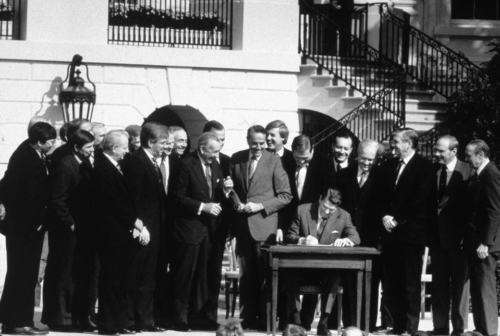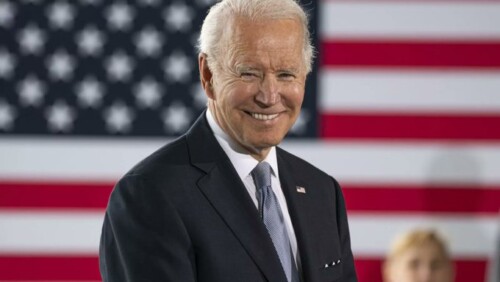RealClearBooks: Who Will Break the Spell of Polarization?
07.14.2015
Republicans are frequently blamed for America’s intensifying political polarization, and not without cause. Surveys show that they have moved farther to the right than Democrats have to the left and are less disposed to political compromise. The GOP also benefits more from polarization, in that it induces paralysis in Washington. For conservatives who see the federal government as a wealth- and liberty-destroying Leviathan, political obstruction is no vice.
Yet liberals seem to be warming to the new politics of polarization, too. Just as anti-government populism animates the right, anti-corporate populism is ascendant on the left. Populist tribunes like Senator Elizabeth Warren and New York mayor Bill DeBlasio are preaching a gospel of economic justice through redistribution, while Senator Bernie Sanders is peddling his version of European-style social democracy to ecstatic crowds on the campaign trail.
Can America really be moving simultaneously to the right and the left? Where have all the moderates gone? Are we doomed to political stalemate, or will one of the parties muster a durable majority for its governing vision?
How we came to this impasse, and how it might be broken, is the subject of Shattered Consensus: The Rise and Decline of America’s Postwar Political Order, by conservative scholar James Piereson. Progressives shouldn’t be put off by the author’s conservative leanings; this elegantly written book offers a perceptive if not always convincing guide to how U.S. conservatives understand themselves and their liberal opponents.
Piereson traces our present deadlock to the end of the broad political consensus forged in the crucible of Depression, World War II, and the Cold War. He sees the New Deal realignment as the latest of three “regimes” that have shaped the nation’s political evolution (Jefferson’s revolution of 1800 and the Civil War having set the stage for long stretches of Democratic and Republican ascendance, respectively). At the height of the postwar consensus, liberal ideas dominated U.S. political thought. The rout of laissez-faire economics and isolationism shoved conservatives to the margins, reducing their views, in Lionel Trilling’s memorable phrase, to “irritable mental gestures which seek to resemble ideas.” Americans voiced high levels of trust in government, which after all had saved the free-enterprise system, provided basic social protections for workers and the elderly, and organized the great victory over the Axis powers. Liberal historians like Louis Hartz and Richard Hofstadter proclaimed a national consensus on basic political values—an underlying “American creed” to which both parties adhered, even as they offered varying interpretations of personal liberal and equality.
Reading Piereson brought to mind a conversation I had years ago with another eminent scholar of the consensus school, Seymour Martin Lipset. In postwar Europe, he said, elections were usually contests between parties with distinct ideologies (e.g., Democratic Socialists vs. Christian Democrats) and separate social bases (working class vs. the bourgeoisie). In contrast, he likened U.S. parties to Macy’s and Gimbel’s—rival department stores competing for the same customers.
For better or worse, that dynamic has changed. Traditionally heterogeneous coalitions, U.S. parties are becoming more ideologically cohesive. Republican moderates are now a weak minority and liberal Republicans are virtually extinct. The parties tailor their appeals to different “customers”—the Republicans mainly white, working-class, and older voters, the Democrats young, minority, and highly educated voters. And it’s not just the parties; U.S. voters seem to want to live among people with a similar political outlook, and they’re sorting themselves accordingly.
As Piereson notes, the collapse of a reigning political paradigm makes it hard to cobble together majorities and govern. He wants a government capable of reducing public debt, stimulating economic growth, and reining in entitlement spending. Progressives would add other things to his list, but in either case, America needs a functioning government, even as left and right battle over its proper size and scope.
Piereson argues, plausibly, that the country is ripe for a “fourth revolution” that will realign U.S. politics around a broad majority. Which party is most likely to bring it about?
Here, the author’s analytical acuity deserts him, and partisanship takes the wheel. Take his account of the rise of “punitive liberalism” in the 1960s and 1970s. As liberal reformism curdled into hatred of U.S. society, Piereson suggests, liberals used government to push busing and other measures intended to “punish the nation for its past crimes.” Well, yes, some radicals spelled America with a “K” and called for revolution. But mainstream liberals fought nobly to advance civil rights; waged war on poverty, with less success; defended democracy against Soviet communism; tackled industrial pollution for the first time; and, ended a deeply divisive war in Vietnam. Did they leverage an affluent society’s sense of guilt to achieve these goals? Sure, but their aims were plainly ameliorative, not punitive.
Similarly skewed is Piereson’s caricature of President Obama as a ruthless partisan determined to foist a social-democratic agenda on the country. In fact, Obama ran a philosophically vague campaign in 2008, emphasizing his credentials as a “post-partisan” outsider who could rise above the toxic polarization in Washington. He did campaign on expanding health-care coverage—an idea that enjoyed majority support in 2008—but the plan he proposed once in office was a huge disappointment to the left, which wanted then, as it wants now, a single-payer plan.
Piereson also accuses Obama of “disdaining any compromise with Republicans over budget issues.” In fact, Obama sought a grand fiscal bargain after the 2010 elections, but congressional Republicans were mainly interested in killing Obamacare, even at the risk of government shutdowns and default. Deals were struck to whittle down the deficit, but generally on conservative grounds—as liberals bitterly noted—since most of the savings came from domestic spending cuts rather than from tax hikes. Any dispassionate observer of this president (and I speak as a Hillary supporter in 2008) has to admit that pragmatism, not ideology, is Obama’s political lodestar.
Piereson skips over the 1990s, possibly because the Clinton years belie his narrative of a Democratic party captured by liberal elites and alienated from Middle America. The advent of the New Economy and the Internet; vibrant growth and full employment; steep reductions in poverty and welfare dependence; falling crime and teen pregnancy rates; and, for good measure, a balanced budget—this recent stretch of effective progressive governance is conspicuously absent from Shattered Consensus.
Piereson hits nearer the mark in his account of Democrats’ current obsession with inequality and redistributionist politics, which he thinks will trigger a voter backlash against higher taxes and more intrusive government. One Republican presidential candidate who seems to agree is Jeb Bush, who has made 4 percent growth his campaign calling card. Whatever happens next year, Piereson is right to identify slow economic growth as the main challenge confronting America’s next “political regime.”
And plenty of pragmatic Democrats share that view: Hillary Clinton said as much in an interview with Charlie Rose, though she hasn’t emphasized the point recently. But imagine a 2016 presidential race that centers not on the ritual flaying of big government or big business, but on which party has the best ideas for reviving U.S. economic dynamism and shared prosperity. That would be a welcome sign that, consensus or no, our democracy is working again.





